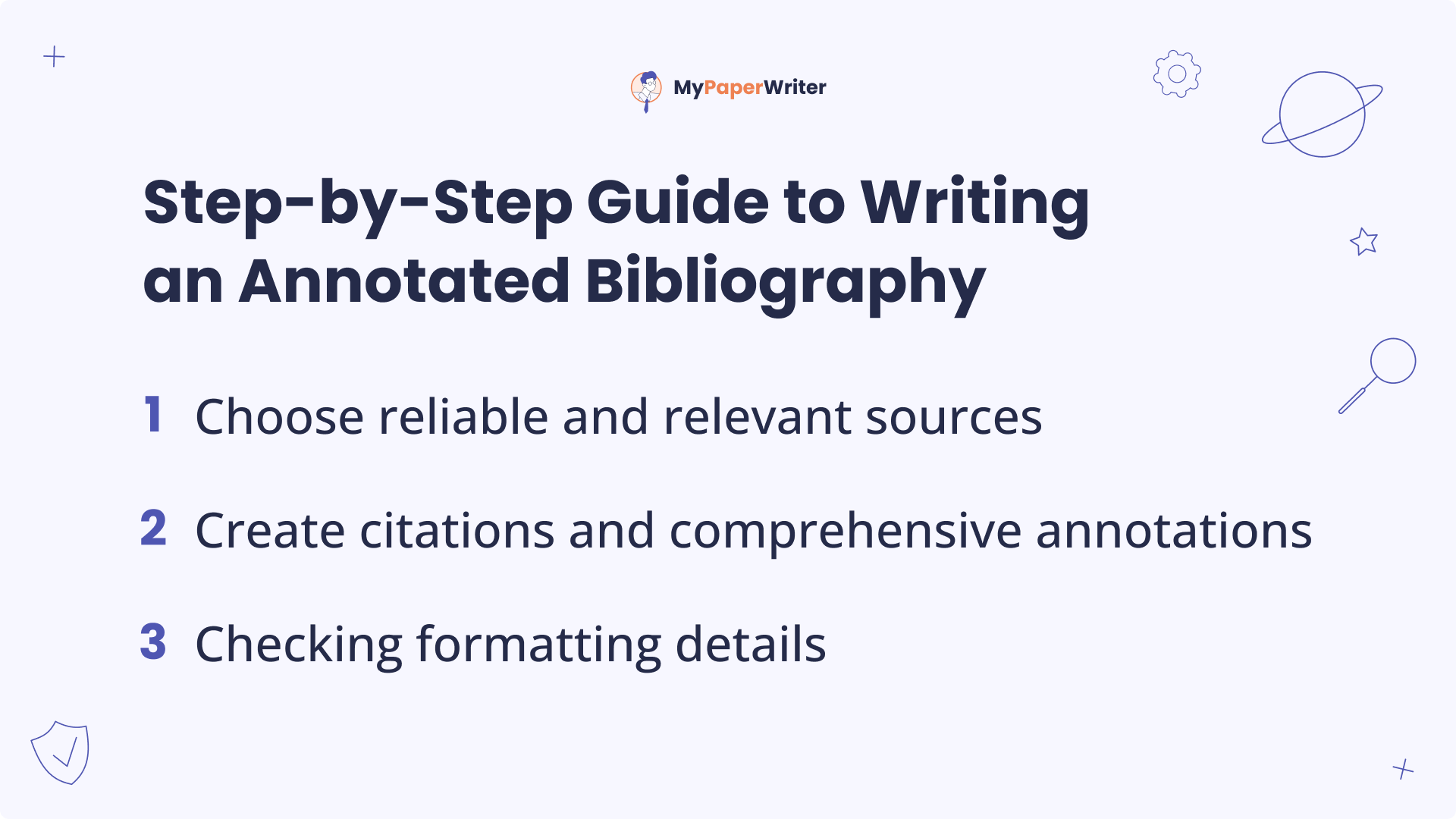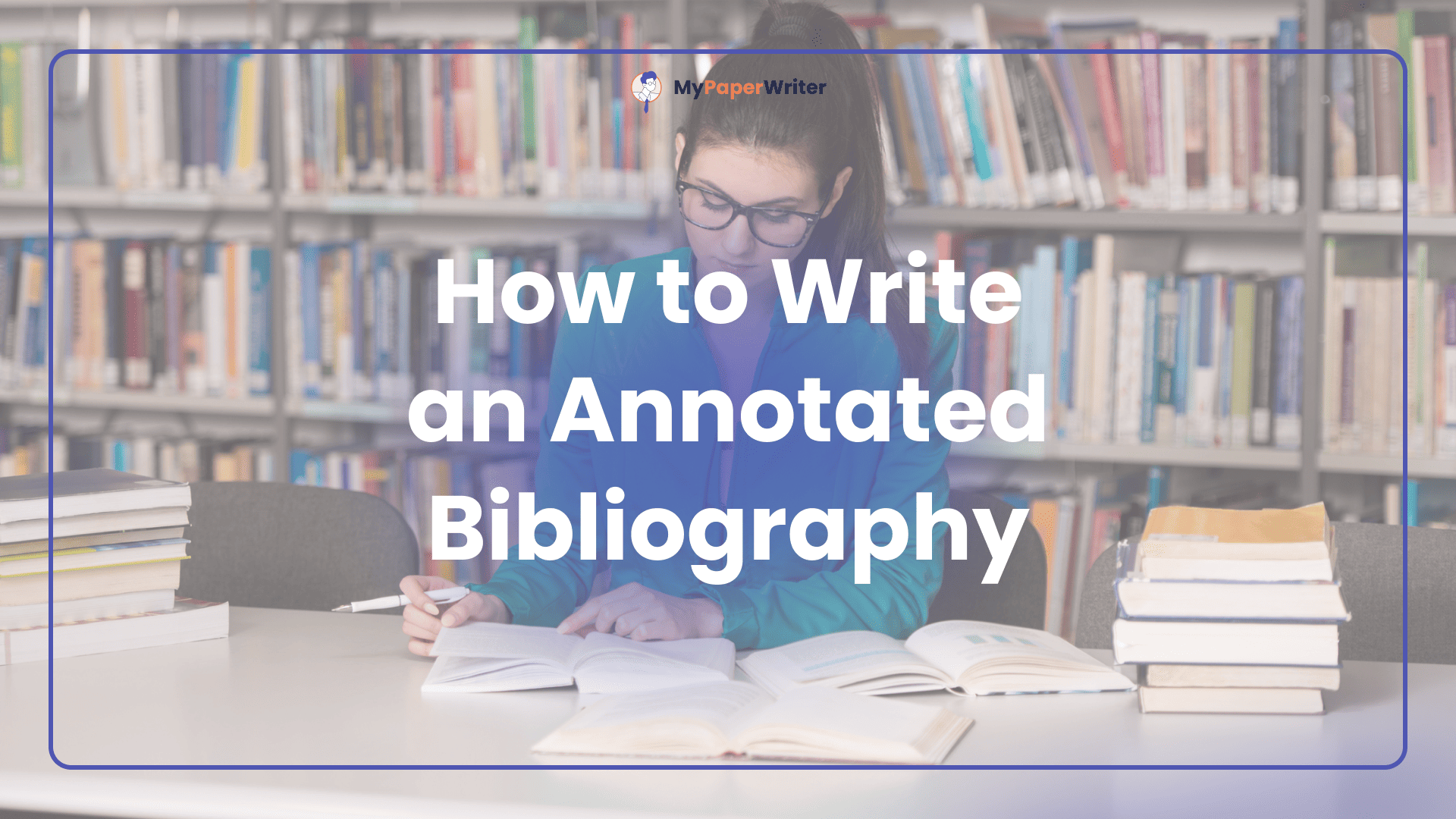Many students hope to learn how to do an annotated bibliography, but the problem is, they have no idea where to start. If you’re in the same boat, relax! We’ve got you covered. This guide has been prepared by academic experts who’ve written all kinds of college and university projects and received accolades for their efforts.
First, we’ll establish what annotated bibliography is. Then, we’ll explore its purpose and the formats students usually need to use in their papers. Most importantly, we’ll share the tried and tested tips on how to write this type of work while getting the highest grades for it.
Table of Contents
- What Is Annotated Bibliography & What It Shouldn’t Be
- Understanding the Purpose of an Annotated Bibliography
- How to Situate the Elements in the Annotated Bibliography?
- How to Write an Annotated Bibliography in Three Steps
- Annotated Bibliography Examples in APA, MLA, and Chicago
- A Sample of APA Annotated Bibliography
- A Sample of MLA Annotated Bibliography
- A Sample of a Chicago Annotated Bibliography
- Create Your Annotated Bibliography Like a Pro
What Is Annotated Bibliography & What It Shouldn’t Be
Let’s get the most immediate questions out of the way. What is a annotated bibliography, and at what stage is it written? Annotated bibliography is a list featuring information about the books, articles, websites, and other resources a writer used or is planning to use in their research. Most people compose it early on, and that’s a good decision. Your professor might need to see what kind of sources you’ve selected. This way, if you have some bad choices in there, you’ll get a chance to correct the situation before writing your paper.
So far, everything seems pretty simple, doesn’t it? But then why do so many students prefer to hire an annotated bibliography writing service rather than work by themselves? This is where we go back to the definition we’ve just established. Annotated bibliography is not just a mention of a source’s title and its author. It’s also not a simple summary. Keep these facts in mind because they result in common mistakes. To understand what a bibliography involves in reality, you need to know what it’s for.
Understanding the Purpose of an Annotated Bibliography
The purpose of an annotated bibliography is to explain what sources you’ll be working with and why. It requires a source overview, evaluation, and relevance analysis. An overview functions as a summary. It’s just one of three essential components you’ll have to include, so you must make it concise yet detailed at the same time. The overview demonstrates what a specific source is about and which viewpoint its author embraces.
Evaluation, in turn, underlines how credible your chosen article is. Is it outdated or modern? Did it undergo a peer review, or was it published independently? Establishing these factors allows your audience to decide whether they can trust a source.
Relevance analysis shows what link a source has to your research. Together, these three elements form the key purpose of annotated bibliography, which is to give your readers an understanding of your source, its contents, credibility, and relevance.
If you find the thought of incorporating these features intimidating, you can always seek help from experts and tell them, “Write my paper and add annotated bibliography to it.” But if you’re still determined to write everything on your own, stay tuned.
How to Situate the Elements in the Annotated Bibliography?
The next thing we should explore is the annotated bibliography format. By now, you have a basic idea of what it involves, but you must also understand which elements to write in what order. Overall, a standard annotated bibliography can be broken into two large parts of equal significance. Here they are.
Full and Properly Formatted Citation
Students always need to write their content in a specific academic formatting style. The most common options include MLA and APA. The other slightly less popular styles are Harvard and Chicago. Your bibliography will typically follow an alphabetical order, so situate your sources accordingly.
Sort them by the author’s last name. An article by Anderson W. will precede a book published by Bonnet A., and so on. Include the title, publication date, the name of a journal or a publishing house, and other features required by your chosen formatting style.
A Comprehensive Annotation with All Its Elements
Once you create a citation, it’s time to start writing the annotation itself. Hopefully, you remember what components it consists of, but we can go over them again.
- Provide a short summary of your source, briefly mentioning what topics it tackles and which concepts it explores.
- Evaluate your source in terms of its trustworthiness. Mention its strengths and drawbacks. Pay attention to its date and the author’s credentials in particular because these factors can drag you down.
- Establish the relevance of your source to your study. Discuss the angles it adds to the research you’re planning, your reasons for selecting it, and its connection to other sources.
How to Write an Annotated Bibliography in Three Steps
Every writer has their unique writing strategies. We encourage students to develop their own approach to academic tasks, but naturally, such things can only happen with practice. What if you need to write your annotated bibliography right now?
The most important advice is, don’t panic. We will offer three key steps that will guide you through the process even if you’re a total writing newbie.

1. Choose Reliable and Relevant Sources
Selecting the best and the most relevant books and articles is key to creating a worthy annotated bibliography. This might surprise you, but if you fail at the first stage, you will fail your task entirely, no matter how accurately you follow the other steps.
Your bibliography won’t mean much unless it features solid and reliable entries. Look for sources created within the last 3-5 years. The only exception would be books or articles exploring a rare topic or something with historical value. Make sure DOI is present for articles. When it comes to books, go for those released by academic publishing houses.
2. Create Citations and Comprehensive Annotations
Time to start writing an annotated bibliography. Add a citation in your formatting style and proceed to create an honest annotation. Be mindful of its size. A typical entry should have 100-200 words unless specified otherwise. Dedicate a couple of sentences to a summary. Then, move on to the evaluation stage.
Be honest about the value of your source. Is it really trustworthy? What drawbacks does it have? Acknowledge them openly. Your future readers deserve to know all the details because it will influence how they view your research and its findings.
Finally, write several more sentences analyzing how this source relates to your sub-topic in particular. Once again, be transparent and comprehensive. Focus on specific points of connection that are relevant to your research.
3. Double-Check the Formatting Details
Creating annotated bibliography tends to be boring and time-consuming for many students. The last thing they want is to go back to it again, but unfortunately, this is something you must definitely do if you want to get a good grade. Now that everything is done, you need to perform a good old round of editing.
While your text deserves your attention, it’s the formatting you should focus on first and foremost. Such details as the use of italics, initials, and punctuation vary wildly from style to style, so you need to be sure you’ve formatted everything correctly. Consult a template again, then inspect your entries. Is everything good? Add the last polishing touches where needed.
Annotated Bibliography Examples in APA, MLA, and Chicago
As mentioned above, the most common formatting styles are MLA and APA. Chicago comes third. Since there are good chances you’ll be working with one of them, we decided to present several samples of annotated bibliographies formatted in these styles. Check them out and remember how everything should be done.
A Sample of APA Annotated Bibliography
Research Article in APA
Williams, M. (2023). Failing media literacy course on the example of BBC Sherlock. The New Media Outlook, 12(2), 3–43. DOI.
Williams’ article explores the problem of media literacy among modern filmmakers by using BBC Sherlock as an example. He underlines the narrative of the first three seasons, dissects character motivation, and illustrates how in season 4, the previous cohesiveness was lost.
Williams has a Media degree and 10 years of experience. His article includes thoughtful analyses, direct examples, and clear explanations, all which add value to it.
This article will be a solid foundation for illustrating how the lack of media comprehension and a cheap desire to shock the audience can lead to a media disaster.
Note that the entries in most annotated bibliographies are written in one chunk, with no paragraph breaks. We included the breaks in our sample to emphasize three different components you need to be familiar with. So, the first paragraph is an overview, the second one is an evaluation, and the third one offers a relevance analysis.
Annotated Bibliography APA for Book Entry
Clayton, V. (2024). How the US never stopped earning blood money. Frankfurt University Press.
Clayton’s book focuses on American participation in many different wars across the world. He lists these wars, shows the evidence of the US’ involvement, and tracks down the key reasons for it.
Clayton has experience as a war journalist and an established researcher. His works are accepted and published by multiple respectable academic publishing houses.
His book links the US to the war in Ukraine, which is the topic of the upcoming research. Namely, Clayton provides evidence proving that the US continues to sell war-related components to Russia while limiting its help to Ukraine, which makes it a criminal similar to Iran and North Korea.
A Sample of MLA Annotated Bibliography
Research Article in MLA
Hale, Sandy. “Fanfiction Is a True Form of Art.” Lit Times, vol. 11, no. 2, 2023, pp. 6-23.
Hale’s article dissects the concept of fanfiction and argues about its value in the world of literature. The author introduces the arguments and counter-arguments before arriving at the conclusion that fanfiction deserves to be recognized as a transformative art form.
Hale is a literature major who has authored several books. Her works always received positive reviews from academic critics.
The article benefits the planned research because it explores all sides of fanfiction. It has many relevant examples and facts.
Annotated Bibliography MLA for Book Entry
Sawyer, Patricia. How Students’ Involvement Helps Senior Population. Denver Publishing, 2022.
Sawyer’s research consists of case studies showing that the elderly experience significant improvement in their cognitive and social abilities after interacting with younger people. The author focuses on students and the volunteer work they do at nursing homes.
Sawyer has a nursing degree, which allows her to understand the results of medical case studies properly. In addition, she volunteered at a nursing home as a student herself.
Sawyer’s book solidifies the idea that governments should implement multiple campaigns to engage students in volunteer work with the elderly. It offers quantitative data and objective analysis on this topic, which is the heart of the upcoming research.
A Sample of a Chicago Annotated Bibliography
Research Article in Chicago
Collins, Jane S. Benefits of Meditation for Teenagers. Teen Development, vol. 3, no. 2, 2023, pp. 122-168.
Collins’ article explores the elevated stress levels among teenagers and meditation as a means of overcoming this problem. The author performed primary research by interviewing 15 teenages and asking them to meditate for the duration of a month. Then, she analyzed the results.
Collins is an established researcher with a medical degree and a decade of experience working as a yoga trainer. Her research is of the primary type, which increases its value.
Collins’s findings correlate with a proposed hypothesis that meditation has healing properties. They help prove that teenagers, one of the most vulnerable population groups, can calm their minds sufficiently by meditating.
Chicago Style Annotated Bibliography for a Book Entry
Smith, Henry. Panic Attacks: Old and New Treatments. New York: NY Press, 2023.
The book by Smith dives into the evolution of knowledge about panic attacks. It addresses different types of medication, from old to new, before settling on the mixed approach being the perfect option.
Smith does not have a relevant degree, which lessens his credibility to an extent. However, he has been suffering from panic attacks for his entire life, and he volunteered at a community center dedicated to this issue, which gives him primary experience.
Smith’s work is essential because it presents a detailed overview of everything known about panic attacks. Its value lies in the multiple historical facts it includes.
Create Your Annotated Bibliography Like a Pro
You know how to write an annotated bibliography now. That’s great! With all the knowledge tucked safely in your mind, you should start working on your project. Remember the structure. Include a summary, assessment, and relevance analysis. Don’t spend too much time on one of these components because your word count is severely limited.
If you still worry about your bibliography or some other academic project, remember that you can buy college papers online anytime. There are experts equipped with all the necessary skills who can help you. Select credible sources, start writing, and try to enjoy what you do!

